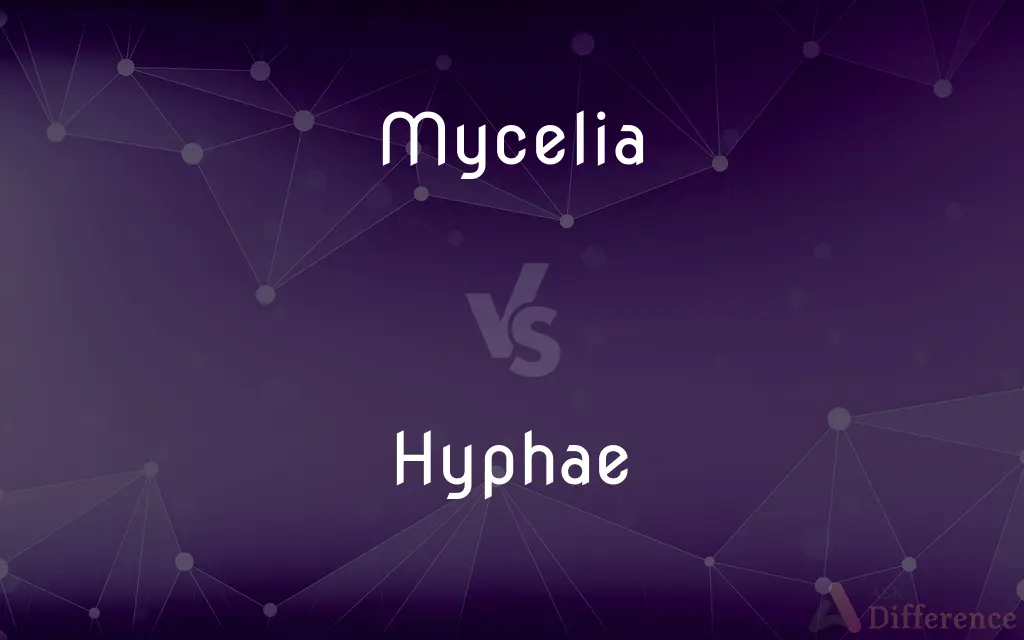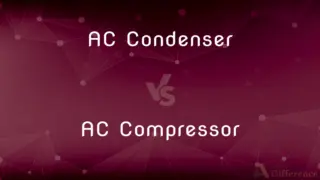Mycelia vs. Hyphae — What's the Difference?
By Tayyaba Rehman & Urooj Arif — Published on March 9, 2024
Mycelia are the complex, branching networks of fungal organisms, composed of individual filaments called hyphae, which serve as the main mode of growth and nutrient absorption for fungi.

Difference Between Mycelia and Hyphae
Table of Contents
ADVERTISEMENT
Key Differences
Mycelia represent the vegetative part of a fungus, consisting of a network of hyphae. This structure is usually found underground or within the substrate on which the fungus grows, such as decaying wood or soil. Mycelia are responsible for the absorption of nutrients, aiding in the decomposition of organic material and contributing to nutrient cycling in ecosystems. The mycelium's extensive network allows fungi to cover large areas, efficiently absorbing water and nutrients.
Hyphae are the individual filaments that make up the mycelium. Each hypha is a tubular structure, usually only one cell thick, divided by septa (cross walls) in many fungi, which may contain pores allowing for the flow of cytoplasm and nutrients between cells. Hyphae grow at their tips, extending into new territories and absorbing nutrients through their cell walls. They can differentiate into various structures depending on their environment and the fungal species, including those involved in reproduction, nutrient absorption.
The relationship between mycelia and hyphae is one of structure and function, where hyphae are the building blocks, and mycelia are the complex structures they form. Mycelia are crucial for the survival and growth of fungi, facilitating not only nutrient uptake but also the production of spores for reproduction. Hyphae, by their growth and branching, enable the mycelium to explore and exploit their environment effectively.
Both mycelia and hyphae are integral to the fungal life cycle and play significant roles in ecosystems, such as decomposing organic matter, forming symbiotic relationships with plants (e.g., mycorrhizae), and participating in soil formation and stabilization. Despite their often-hidden nature, their impact on the environment is profound, influencing soil fertility, plant health, and the decomposition of organic material.
Comparison Chart
Definition
The complex, branching network structure of a fungus.
The individual filaments that make up the mycelium.
ADVERTISEMENT
Function
Absorption of nutrients, growth, and reproduction of the fungus.
Growth into new areas, nutrient absorption, and structure differentiation.
Composition
Composed of many hyphae.
Single tubular structures, potentially divided by septa.
Location
Usually underground or within a substrate (e.g., wood, soil).
Part of the mycelium, extending into the environment.
Role in Ecosystem
Decomposition, nutrient cycling, symbiotic relationships.
Enabling mycelial expansion, environmental exploration, and exploitation.
Compare with Definitions
Mycelia
Integral for fungal communication and nutrient distribution.
Mycelia can transport nutrients across large distances to support growth in nutrient-poor areas.
Hyphae
Capable of altering their growth based on environmental cues.
Hyphae can change direction when they encounter a physical barrier or a more nutrient-rich area.
Mycelia
Capable of rapid expansion under suitable conditions.
A mushroom's mycelium can colonize a log completely in just a few months.
Hyphae
Essential for the fungal life cycle and reproduction.
Certain hyphae develop into spore-producing structures, critical for fungal propagation.
Mycelia
Forms the foundation of complex fungal structures.
The fruiting bodies of mushrooms are supported by an extensive mycelial network.
Hyphae
Exhibit chemotropic growth, moving towards specific chemicals.
Hyphae can grow towards the scent of decaying organic matter, indicating nutrient availability.
Mycelia
Facilitates the production of antibiotics and enzymes.
The mycelium of Penicillium fungi produces the antibiotic penicillin.
Hyphae
Can differentiate into specialized structures.
Some hyphae transform into rhizoids that anchor the fungus to the substrate.
Mycelia
Serves as an ecological connector and recycler.
Mycelia break down dead wood, turning it into fertile soil.
Hyphae
Involved in the formation of mycorrhizal associations.
Hyphae penetrate plant root cells to establish a nutrient exchange interface.
Mycelia
The vegetative part of a fungus, consisting of a mass of branching, threadlike hyphae.
Hyphae
Any of the threadlike filaments forming the mycelium of a fungus.
Mycelia
A similar mass of fibers formed by certain bacteria.
Hyphae
Any of the threadlike filaments produced by certain bacteria.
Mycelia
Plural of mycelium
Hyphae
Plural of hypha
Hyphae
The long, branching filaments of which the mycelium (and the greater part of the plant) of a fungus is formed. They are also found enveloping the gonidia of lichens, making up a large part of their structure.
Common Curiosities
Can mycelia be seen with the naked eye?
While individual hyphae are microscopic, mycelia can often be seen with the naked eye, especially when they form dense networks.
How do mycelia interact with plants?
Many mycelia form symbiotic relationships with plants, such as mycorrhizae, where the fungus enhances plant nutrient uptake in exchange for carbon compounds from the plant.
How do hyphae contribute to a fungus's growth?
Hyphae grow by extending their tips, allowing the fungus to explore and exploit new areas for resources, directly contributing to the organism's growth.
How do mycelia contribute to soil health?
Mycelia help decompose organic material, returning nutrients to the soil and improving soil structure, which enhances water retention and aeration.
How do environmental conditions affect mycelial growth?
Mycelial growth is influenced by factors like temperature, humidity, and the availability of nutrients, with optimal conditions leading to rapid expansion.
What is the ecological significance of hyphae in forests?
Hyphae contribute to forest ecosystems by decomposing organic matter, recycling nutrients, and forming symbiotic relationships with trees, enhancing their growth.
What is the main function of mycelia in fungi?
Mycelia absorb nutrients from the environment, support fungal growth and reproduction, and play a vital role in decomposition and nutrient cycling.
What role do hyphae play in nutrient absorption?
Hyphae secrete enzymes that break down complex molecules in the environment, allowing the fungus to absorb simpler compounds directly through their cell walls.
How do mycelia and hyphae adapt to harsh environments?
Mycelia and hyphae can enter dormant states, alter their metabolic pathways, or produce protective compounds to survive in extreme conditions.
What is the difference between septate and coenocytic hyphae?
Septate hyphae have cross-walls (septa) that divide them into compartments, while coenocytic hyphae lack these dividers and have multiple nuclei within a continuous cytoplasm.
Are all mycelia beneficial to their environments?
While many mycelia play beneficial roles in decomposition and symbiosis, some can be pathogenic to plants, animals, and humans, causing diseases.
Can mycelia harm plants or trees?
While many mycelia are beneficial, some pathogenic fungi use their mycelia to infect and damage plants and trees, leading to diseases.
How do mycelia contribute to carbon sequestration?
By decomposing organic matter, mycelia convert carbon into forms that can be stored in the soil for long periods, helping to sequester carbon.
Can mycelia be used in biotechnology?
Yes, mycelia are explored for various biotechnological applications, including bioremediation, sustainable material production, and as sources of pharmaceuticals.
What role do hyphae play in fungal resistance to antibiotics?
Hyphae can evolve mechanisms, such as modifying their cell walls or producing enzymes, to resist the effects of antibiotics.
Share Your Discovery

Previous Comparison
Ancient Greece vs. Ancient Rome
Next Comparison
AC Condenser vs. AC CompressorAuthor Spotlight
Written by
Tayyaba RehmanTayyaba Rehman is a distinguished writer, currently serving as a primary contributor to askdifference.com. As a researcher in semantics and etymology, Tayyaba's passion for the complexity of languages and their distinctions has found a perfect home on the platform. Tayyaba delves into the intricacies of language, distinguishing between commonly confused words and phrases, thereby providing clarity for readers worldwide.
Co-written by
Urooj ArifUrooj is a skilled content writer at Ask Difference, known for her exceptional ability to simplify complex topics into engaging and informative content. With a passion for research and a flair for clear, concise writing, she consistently delivers articles that resonate with our diverse audience.














































